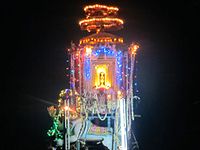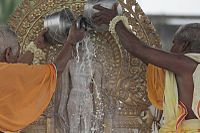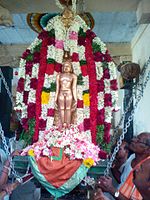
The Śvētāmbara is one of the two main branches of Jainism, the other being the Digambara. Śvētāmbara means "white-clad", and refers to its ascetics' practice of wearing white clothes, which sets it apart from the Digambara "sky-clad" Jains, whose ascetic practitioners go naked. Śvētāmbaras, unlike Digambaras, do not believe that ascetics must practice nudity.

Tamil Jains are Tamils from Tamil Nadu, India, who practice Digambara Jainism. The Tamil Jain is a microcommunity of around 85,000, including both Tamil Jains and north Indian Jains settled in Tamil Nadu. They are predominantly scattered in northern Tamil Nadu, largely in the districts of Madurai, Viluppuram, Kanchipuram, Vellore, Tiruvannamalai, Cuddalore and Thanjavur. Early Tamil-Brahmi inscriptions in Tamil Nadu date to the 3rd century BCE and describe the livelihoods of Tamil Jains. Samaṇar wrote much Tamil literature, including the important Sangam literature, such as the Nālaṭiyār, the Silappatikaram, the Valayapathi and the Seevaka Sinthamaṇi. Three of the five great epics of Tamil literature are attributed to Jains.

Parshvanatha, also known as Parshva and Paras, was the 23rd of 24 Tirthankaras of Jainism. He is the only Tirthankara who gained the title of Kalīkālkalpataru.

Padmāvatī is the protective goddess or śāsana devī (शासनदेवी) of Pārśvanātha, the twenty-third Jain tīrthāṅkara, complimenting Parshwa yaksha, the shasan deva. She is a yakshi of Parshwanatha.

Sri Venkateswara Swami vari Brahmotsavam or Srivari Brahmotsavam is the most significant annual fête celebrated at the Venkateswara Temple in Tirumala-Tirupati, Chittoor district, Andhra Pradesh, India. The feast lasts for one month during the Hindu calendar month of Āśvina, which falls between the Gregorian calendar months of September and October.

Nagaraja Temple is an early large temple found in the city of Nagercoil (Nagarkōyil) near the southern tip of Tamil Nadu, India. Its dating is uncertain but likely pre-12th-century. The main sanctum is dedicated to the Nagaraja – the king of serpents. Padmanabham (1985), Heritage Of The Tamils Temple Arts, Editors: SV Subramanian and G Rajendran, International Institute of Tamil Studies, Since the 17th-century, new Hindu shrines have been added to the temple complex attracting devotees of Krishna (Vishnu), as well as Shaiva and Shakti Hindus. The original iconography of the Tirthankaras and Padmavati Devi have and continue to remain a part of the sacred pantheon close to the temple's main sanctum.
Jain rituals play an everyday part in Jainism. Rituals take place daily or more often. Rituals include obligations followed by Jains and various forms of idol worship.

Suparshvanatha, also known as Suparśva, was the seventh Jain Tīrthankara of the present age (avasarpini). He was born to King Pratistha and Queen Prithvi at Varanasi on 12 Jestha Shukla in the Ikshvaku clan. He is said to have attained moksha at Shikharji on the sixth day of the dark half of the month of Phālguna.
Upākarma "Beginning", also called Āvaṇi Aviṭṭam, Āvaṇi Aviṭṭam, Janivārada Huṇṇime, Gahmā Pūrṇimā, Jaṁdhyāla Paurṇami is a Vedic ritual practiced by Hindus of the Brahmin caste. This ritual is also practiced by the Kshatriya and Vaishya community, who are dvijas and therefore have the rights to do Sandhyavandanam, the daily ablution ritual.

Ratha Saptami or Rathasapthami is a Hindu festival that falls on the seventh day (Saptami) in the bright half of the Hindu month Maagha. It is symbolically represented in the form of the Sun God Surya turning his Ratha (Chariot) drawn by seven horses towards the northern hemisphere, in a north-easternly direction. It also marks the birth of Surya and hence celebrated as Surya Jayanti.
Sri Prasanna Venkata Narasimha Perumal is a Hindu temple in Saidapet, Chennai, in the Indian state of Tamil Nadu. It is dedicated to Venkateswara, an incarnation of the Hindu deity Vishnu. It was constructed during the 15th century, but, according to historical records and inscriptions found within the temple, may consist of elements dating back more than 1000 years. The temple was constructed during the era when the South India was under the rule of the Vijayanagara Empire.

Mallinathaswamy Jain Temple is a Jain temple dedicated to the deity Jain, located in Mannargudi, an ancient town in the erstwhile Chola Empire in Tiruvarur District of Tamil Nadu, India. Mallinathaswamy or Māllīnātha is the 19th Tirthankara of the Jain faith.

Venkanna Babu Kalyāṇōtsavām at Yanam is an annual festival at Yanam Venkanna Babu Temple celebrated for twenty four days in the month of Phālguṇa (February/March). The celebration attracts pilgrims and tourists from many parts of around Yanam. Kalyāṇam will be performed on Phālguṇa Śuddha Dvādaśi i.e., on the twelfth day of the festival.
Yanam Śrī Rājarājeśwara Kalyāṇōtsavām at Yanam is an annual festival at Yanam Sivalayam celebrated for twenty days in the month of Māgha (January/February). Kalyāṇam will be performed on Māgha Śuddha Dvādaśi i.e., on the twelfth day of the festival. Lord's holy consort is Goddess Śrī Rājarājeśwari Ammavāru.

Jain sculptures or Jain idols are the images depicting Tirthankaras. These images are worshiped by the followers of Jainism. The sculpture can depict any of the twenty-fourtirthankaras with images depicting Parshvanatha, Rishabhanatha, or Mahāvīra being more popular. Jain sculptures are an example of Jain art. There is a long history of construction of Jain sculptures. Early examples include Lohanipur Torsos which has been regarded to be from the Maurya period, and images from the Kushan period from Mathura.
Panch Kalyanaka are the five chief auspicious events that are believed to occur in the life of tirthankara in Jainism. They are commemorated as part of many Jain rituals and festivals.

Pachaimalai Arulmigu Subramanyaswamy Temple, also known as the Pachaimalai Balamurugan Temple, is one of the two major hill temples located in Gobichettipalayam, Tamil Nadu. The temple is dedicated to the Tamil God Murugan. The temple is constructed in the Tamil style of architecture and is located on top of a small hillock in the outskirts of the town of Gobichettipalayam near Pudupalayam.
Jain festivals occur on designated days of the year. Jain festivals are either related to life events of Tirthankara or they are performed with intention of purification of soul.
Veeramakaliamman Temple is situated at Arantangi in Pudukkottai district in Tamil Nadu, India.



















